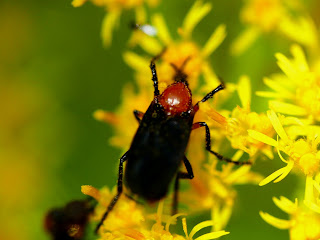March Flies
Here's a species of March Fly that's been identified as Dilophus spinipes, a species without a common name. (They probably consider themselves "uncommonly good flies" for this reason.)
Though there are significantly smaller flies, these guys are on the small side. I'm pretty sure those are goldenrods that the fly's on, and the goldenrod flowers are pretty small. These flies are somewhat noticeable because:
- Their black-and-red coloring stands out pretty well on the yellow goldenrod flowers.
- There tend to be a bunch of them around. It's easy to overlook 1 tiny, weird thing on a goldenrod patch; it's harder to overlook a dozen or more.
Though they're considered March Flies, a group that tends to be spotted in (unsurprisingly) March, some species (including this one) can be found during other parts of the warmer months. This one was photographed in September. Some March Flies don't eat as adults while others are pollinators as adults; based on their scurrying around on goldenrods, I'm confident that this species is a pollinator.
As little larva, they eat organic matter, and can apparently damage the roots of some plants. Given that a webpage suggested releasing chickens on them (chickens do like their larvae) I'm assuming the fly larva goes after roots near the surface.
While trying to dig up some information on March Flies, I discovered that in Australia March Flies are a much different type of fly; down under it's a name for horse flies, one of the bitier insects. Our March Flies and the Australian March Flies are not close relatives.
 |
| September 23, 2020 at Duke Farms Photo 98171040, (c) jpviolette, some rights reserved (CC BY-NC) |



Comments
Post a Comment